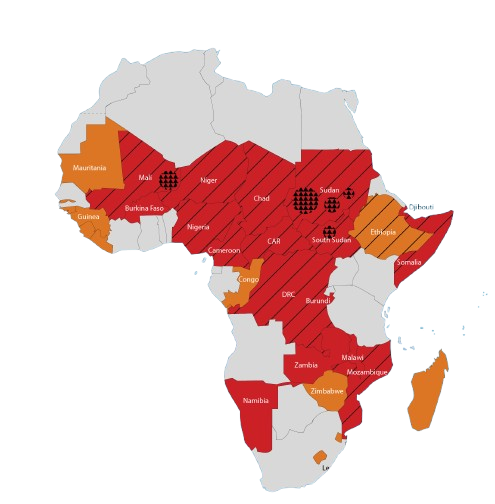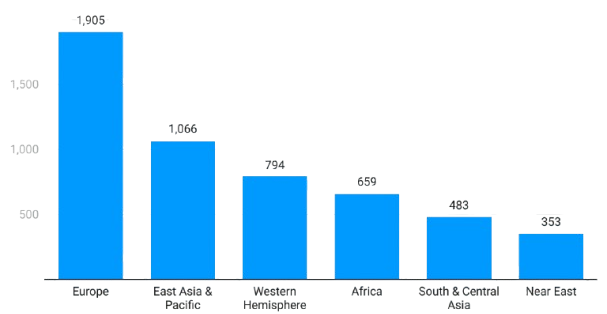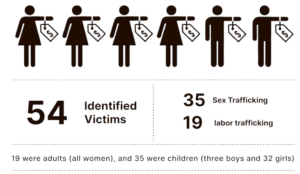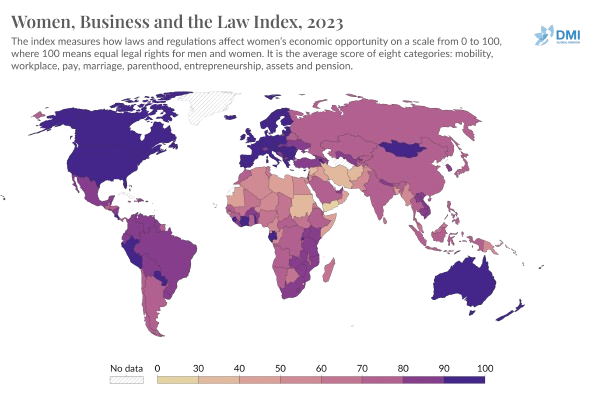OVER 1 MILLION LIVES IMPACTED
0,207
CHILDREN & YOUTH
0,623
WOMEN
0,895
FAMILIES
THE ISSUES
HUMAN TRAFFICKING
Human trafficking, or modern-day slavery, is a global issue that affects every region, country, and community. According to the International Labour Organization’s 2022 report, around 49.6 million people experienced forced labor or forced marriage in 2021, including 6.3 million exploited in forced commercial sex. The highest numbers are found in Asia and the Pacific (29.3 million), followed by Africa (7 million), Europe and Central Asia (6.4 million), the Americas (5.1 million), and the Arab States (1.7 million).
Key forms of exploitation include forced labor, forced marriages, and the sexual exploitation of women and children. Root causes of modern slavery include economic hardship, violent conflicts, displacement, and humanitarian or environmental crises.
In Tanzania, with a population of 66.6 million as of 2023, 43% of citizens are under the age of 15. The population is primarily rural (62.3%), with a slight female majority (50.6%). Tanzania’s efforts to combat trafficking, including amending its 2008 anti-trafficking law, have positioned it in Tier 2 globally, indicating ongoing but limited progress in addressing human trafficking.
CONFLICT and DISASTER
Africa currently has more than 35 non-international armed conflicts (NIACs) taking place in the Central African Republic (CAR), South Sudan, Sudan, Burkina Faso, Cameroon, The Democratic Republic of the Congo, Ethiopia, Mali, Mozambique, Nigeria, Senegal, and Somalia where tens of thousands of people have been killed and millions more displaced. Militarized conflicts in Africa can be caused by any number of factors such as: arbitrary borders created by the colonial powers, multi-ethnic composition of African states, inept political leadership, corruption, the negative effects of external debt burdens, and simple poverty.
 In addition to internal armed conflict, over 1,700 natural disasters have been reported between 1970 and 2019, causing over 730,000 deaths in Africa. Current environmental conditions have increased the occurrence of wildfires, catastrophic flooding and drought making Africa one of the most vulnerable and hardest-hit continents in the world of climate change.
In addition to internal armed conflict, over 1,700 natural disasters have been reported between 1970 and 2019, causing over 730,000 deaths in Africa. Current environmental conditions have increased the occurrence of wildfires, catastrophic flooding and drought making Africa one of the most vulnerable and hardest-hit continents in the world of climate change.
The impact of natural disasters coupled with continued violence, political tensions, war and other armed conflicts across the African continent has had an enduring negative impact on its socio-economic development, promoting widespread poverty and corruption. As one of the poorest continents of the world, 431 million Africans (50% of its rural population) live in extreme poverty with a threshold of $1.90/day.
WOMEN’S INEQUALITY
In 2023, women’s inequality in Africa remains a major challenge, deeply influenced by cultural, economic, and institutional barriers. Despite some progress, women across the continent still face significant disparities in education, healthcare, economic opportunities, and political representation. According to recent data, women make up nearly 50% of Africa’s population, yet their access to resources and decision-making roles remains limited. Gender-based violence, child marriage, and restrictions on reproductive rights continue to affect millions of women, with over 35% of women experiencing some form of physical or sexual violence in their lifetime.
Education inequality is evident: girls are less likely to complete secondary education than boys, with early marriage and pregnancy as contributing factors. Economically, women in Africa earn about 30-40% less than men on average, struggle with limited access to financial services, and face barriers to owning land. Politically, although women’s representation in parliament has increased to an average of 24%, they are still underrepresented in high-level government positions.
Despite these issues, efforts are being made to promote gender equality, including initiatives focused on empowering women economically and enhancing girls’ access to education. However, achieving true equality will require ongoing policy changes, enforcement of laws, and shifts in societal attitudes across the continent.
BARRIERS TO EDUCATION
The impact of poverty on education remains one of Africa’s most difficult challenges. According to the United Nations Education, Scientific and Cultural Organization (UNESCO), more than 20% of African children between the ages of 6 and 11 do not attend school. Nearly 60% of youth between the ages of 15 and 17 are not enrolled. In Tanzania alone, that is more than 1.3 million children between the ages of 6 and 17 with no formal education.
The education of girls is of particular concern. As girls age they drop out of school at a higher rate than their male counterparts. By the time they reach adolescence, girls have a 36% exclusion rate compared to 32% for boys. 9 million girls on the continent between the ages of 6 and 11 will never attend school, compared to 6 million boys.
There are several significant barriers to education, especially for children living in poor rural areas. Many countries lack proper infrastructure to develop utilitarian and safe facilities. Some schools have no bathrooms, desks, or chairs. Of the schools that exist, some can be very far away from the kids who need them. Lack of health and nutrition can often prevent children from being able to attend classes.
Culturally, there is a significant number of the population who are skeptical of the need for a formal education—most especially a formal education for girls. Because of this, schools many times are underfunded and poorly managed. The direct costs charged by public schools including fees, clothing, and books are not easily affordable to many poor families making education a lower priority.
There are currently more than 35 armed conflicts in Africa. There are several armed groups fighting against government forces or fighting with each other throughout the continent. This crisis breeds significant instability in conflict regions disrupting the education system, making it unsafe or even impossible for children to attend school
YOUTH UNEMPLOYMENT
Youth unemployment rates across Tanzania, Zambia, South Sudan, the Central African Republic (CAR), and Malawi reveal a range of economic and social challenges, reflecting disparities in opportunities and infrastructure.
In Tanzania, youth unemployment stands at 3.49% (2023), a relatively low figure compared to global and regional averages. This suggests that the country has managed to integrate many young people into its labor force, although challenges persist in creating high-quality jobs. Much of Tanzania’s economy is agriculture-driven, and the informal sector absorbs a significant portion of the workforce
In Zambia, the youth unemployment rate is alarmingly high, exceeding 20%. This is attributed to slow economic growth, limited industrial development, and the mismatch between educational outputs and job market demands. Many young people rely on informal or underpaid work, highlighting the need for structural reforms and increased investments in sectors that create jobs.
South Sudan faces one of the highest youth unemployment crises, with rates surpassing 30%. Years of conflict have devastated infrastructure, hindered education, and limited access to formal employment. Young people often face a lack of opportunities, pushing many into subsistence agriculture or informal activities for survival.
The CAR, one of the poorest and most fragile nations globally, similarly experiences youth unemployment exceeding 30%. The country struggles with systemic poverty, conflict, and a lack of diversified economic opportunities. These challenges severely impact young people, leaving many unable to find stable employment.
Malawi, while performing better than some of its counterparts, has a youth unemployment rate of approximately 13-15%. Population growth outpaces job creation, and with agriculture dominating the economy, formal employment opportunities remain limited. Education and skills training are areas where further investment could help improve youth employment prospects.
These figures underscore the broader issues facing African economies, including limited industrialization, reliance on agriculture, and the impact of political instability. Addressing youth unemployment in these countries requires a multi-faceted approach, involving investment in education, vocational training, infrastructure, and industrial development. Moreover, fostering political stability and diversifying economic activities can help create sustainable job opportunities for the growing youth population. By tackling these challenges, these nations can unlock the potential of their young workforce and ensure more inclusive economic growth.
IMPACT STORIES
Margaret’s Journey – THE PHEONIX -PNG
Ms. Margaret Gebai’s inspiring journey from a humble beginning to
November 18, 2024
No Comments
Halima’s Journey – FOR FAMILY WELFARE – South Sudan
Ms. Halima Florence, a resident of Joppa village in the
November 18, 2024
No Comments
Mary’s Story – Fertilizer that change lives – Malawi
In recent years, Malawi has faced significant challenges due to
November 18, 2024
No Comments
Celebrating Resiliency: Rehema Path to Healing
Rehema lived with her parents and a younger sibling in
April 8, 2024
No Comments
July 12, 2023
No Comments
Mwantumu’s Story – Tanzania
Once a victim of human trafficking, now a successful entreprenuer
December 13, 2022
No Comments





